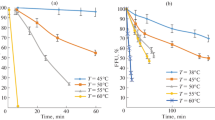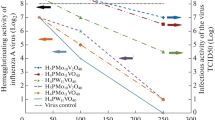Summary
Guanidine hydrochloride or urea selectively inactivated the haemagglutinin (HA) of influenza virus A/Singapore/57 (N2H2), with only slight reduction in neuraminidase (Nase) activity. The results of experiments with isotope-labelled virus, as well as the results of HA-antibody-blocking test suggested that the surface subunits were not released as monomers during the treatment. The inactivation of the HA was thus anin situ process. In this regard the action of guanidine or urea on influenza virus differs from that of other reagents such as detergents commonly used in disruption studies. Electron microscopic examination of treated particles showed that with low molar concentrations of guanidine (1.0 m or 1.5 m) the basic architecture of the virion was retained; higher concentrations (4.0 m or 7.0 m) produced striking swelling of the particles, with disorganized surface “spikes”. Ultracentrifugation studies showed that the residual Nase activity was virionassociated.
Similar content being viewed by others
References
Aminoff, D.: Methods for the quantitative estimation of N-acetyl-neuraminic acid and their application to hydrolysates of sialomucoids. Biochem. J.81, 384–392 (1961).
Biddle, F.: The action of protease on influenza A 2 virus. J. gen. Virol.2, 19–28 (1968).
Biddle, F., andA. P. Kendal: The selective inactivation of influenza virus haemagglutinin by pyridine. Arch. ges. Virusforsch.33, 99–112 (1971).
Compans, R. W., H. Klenk, L. A. Caliguiri, andP. W. Choppin: Influenza virus proteins. 1. Analysis of polypeptides of the virion and identification of spike glycoproteins. Virology42, 880–889 (1970).
David-West, T. S.: A new genetic marker for influenza virus subunits. Arch. ges. Virusforsch.41, 143–146 (1973).
David-West, T. S., andG. Belyavin: Differential effect of guanidine hydrochloride and heat on the haemagglutinin and neuraminidase of influenza viruses. Arch. ges. Virusforsch.43, 367–376 (1973).
Kendal, A. P., F. Biddle, andG. Belyavin: Influenza virus neuraminidase and the viral surface. Biochim. biophysica Acta (Amst.)165, 419–431 (1968).
Reginster, M.: Effect of pronase on influenza virus. Acta virol.10, 111–116 (1966).
Schulze, I. T.: The structure of influenza virus. 11. A model based on the morphology and the composition of subviral particles. Virology47, 181–196 (1972).
Nermut, M. V.: Further investigation of the fine structure of influenza virus. J. gen. Virol.17, 317–331 (1972).
Webster, R. G., andR. W. Darlington: Disruption of myxoviruses with Tween 20 and isolation of biologically active haemagglutinin and neuraminidase subunits. J. Virol.4, 182–187 (1969).
Author information
Authors and Affiliations
Rights and permissions
About this article
Cite this article
David-West, T.S., Belyavin, G. Biophysical studies on the action of guanidine hydrochloride and urea on influenza virus A/Singapore/57. Archiv f Virusforschung 43, 377–384 (1973). https://doi.org/10.1007/BF01556155
Received:
Issue Date:
DOI: https://doi.org/10.1007/BF01556155




